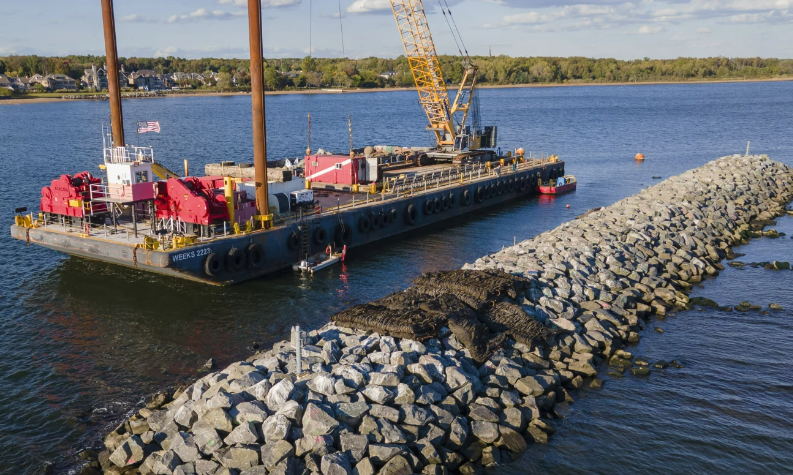
©AP Photo/Ted Shaffrey
Pre-reading questions:
I will read each question. Then, please answer them.
- What is coastal protection?
- Why is protecting coastal areas important?
Vocabulary:
I will read the words, meanings, and sample sentences. Then, repeat after me.
- coastal /KOHS-tl/
- natural /NACH-er-uhl/
- defense /dih-FENS/
- construct /kuhn-STRUHKT/
- health /helth/
[adjective] – relating to or located on the coast
The coastal town is known for its beautiful beaches and lively atmosphere.
[adjective] – existing in or caused by nature; not made or caused by humankind
The park is filled with natural beauty and diverse wildlife to explore.
[noun] – the action of defending from or resisting attack; protection
The team improved its defense to prevent the other side from scoring.
[verb] – to build or form by putting together parts; to create
Workers will construct a new bridge to connect the two sides of the river.
[noun] – well-being and vitality of something
The city’s new park design focuses on enhancing ecological health.
Article reading:
Please read the whole article. Then, I will check your pronunciation and intonation.
In response to the devastation caused by Superstorm Sandy in Tottenville, Staten Island, New York City launched the “Living Breakwaters” project. This initiative aims to provide coastal protection while improving marine ecosystems. When Sandy hit twelve years ago, Tottenville’s limited natural defenses were overwhelmed, leading to tragic losses, including the deaths of a young girl and her father. To prevent such devastation, the project has constructed concrete and rock reefs positioned about 1,000 feet from the shoreline. These structures absorb wave energy and reduce storm impacts. They also promote ecological health by creating features such as tide pools and textured surfaces that attract marine life, including oysters, crabs, and fish. This initiative addresses the negative effects of overfishing and pollution on local habitats.
Funded by $111 million from post-Sandy recovery allocations, the “Living Breakwaters” project represents a pioneering example of hybrid infrastructure. This approach combines environmental restoration with coastal defense strategies. Observations from other communities, such as Cedar Key in Florida and Seattle, reveal growing interest in similar projects. While some local residents have raised concerns about the long-term effectiveness of these breakwaters against severe storms, increased marine activity indicates ecological revitalization and improved community resilience.
Funded by $111 million from post-Sandy recovery allocations, the “Living Breakwaters” project represents a pioneering example of hybrid infrastructure. This approach combines environmental restoration with coastal defense strategies. Observations from other communities, such as Cedar Key in Florida and Seattle, reveal growing interest in similar projects. While some local residents have raised concerns about the long-term effectiveness of these breakwaters against severe storms, increased marine activity indicates ecological revitalization and improved community resilience.
Comprehension questions
I will read each question. Then, please answer them based on the article.
- What event caused New York City to launch the “Living Breakwaters” project?
- How does the “Living Breakwaters” project aim to improve marine ecosystems?
- What were the limitations of Tottenville’s defenses during Superstorm Sandy?
- What types of materials were used to construct the breakwaters?
- How far from the shoreline are the concrete and rock reefs positioned?
Discussion questions
I will read each question. Then, please answer them.
- Have you ever visited a coastal area that was affected by a storm? If so, what did you see? If not, what would you like to learn about such places?
- Do you have any experiences with community projects that help protect the environment? If so, what was your role in the project? If not, how do you think you could get involved in similar projects?
- Do you agree that building structures like breakwaters is a good way to protect coastal areas?
- Why do you think it is important to combine environmental restoration with coastal defense strategies? What benefits could this bring to communities?
- In your opinion, how can communities balance development and environmental protection in coastal areas? What steps can be taken to achieve this balance?